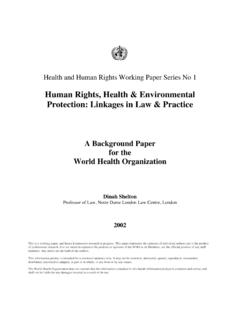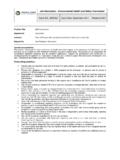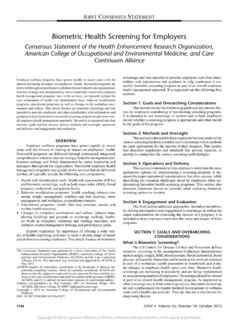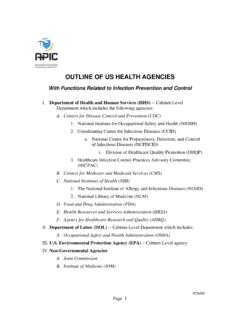Transcription of Compliance of Glass Packaging with Human and …
1 1 Compliance of Glass Packaging with Human and environmental health and Safety Toxics in Packaging Requirements Prepared for the Glass Packaging Institute by: Stephen Paul Mahinka, Esq. Alexis Reisin Miller, Esq. Dr. Jessica L. Vaughn, Regulatory Scientist February 8, 2013 Morgan, Lewis & Bockius LLP 1111 Pennsylvania Ave., Washington, 20004 2 Compliance of Glass Packaging Materials with Relevant Human and environmental health and Safety Regulatory Requirements Table of Contents EXECUTIVE SUMMARY .. 4 I.
2 8 A. 8 B. Heavy Metals .. 10 II. REGULATORY 12 A. Environmentally-Focused Regulations Concerning the Presence of Heavy Metals in 12 1. Model Toxics in Packaging Legislation and Related State Laws .. 12 2. EU Regulation .. 14 B. FDA Regulatory Status of Glass Packaging Materials .. 15 C. FDA and EPA Standards for Heavy Metal Content in Glass Packaging .. 16 1. FDA Limitations on Heavy Metal Impurities in Food Additives .. 17 2. EPA Limitations on Heavy Metal Impurities in Waste .. 19 3. EPA Regulation of Waste Incineration .. 20 III. FEDERAL STANDARDS FOR SAMPLE DIGESTION AND ANALYSIS OF HEAVY METAL CONTENT.
3 24 A. EPA Testing Methods for Solid Waste .. 24 B. CPSC Testing Methods for Children s 29 C. Testing Methods to Assess Presence of Heavy Metals in Municipal Solid Waste Combustion Ash .. 30 IV. ANALYTICAL METHODS USED TO MEASURE HEAVY METAL CONTENT IN CONJUNCTION with TESTING 31 A. Direct Aspiration or Flame Atomic Absorption Spectroscopy ( FLAA ) .. 31 B. Graphite Furnace Atomic Absorbance Spectroscopy ( GFAAS ) .. 32 C. Inductively Coupled Plasma-Atomic Emission Spectroscopy ( ICP-AES ) .. 32 D. Inductively Coupled Plasma-Mass Spectroscopy ( ICP-MS ) .. 33 E. X-Ray Fluorescence Spectrometry ( XRF ).
4 33 V. HEAVY METAL PRESENCE IN Packaging WASTE - TESTING RESULTS USING VARIOUS METHODOLOGIES .. 35 A. Toxics in Packaging Clearinghouse Studies .. 35 1. TPCH 2007 Report .. 36 3 2. TCPH 2009 Update .. 39 3. TPCH 2011 Laboratory Round Robin .. 41 B. Other Relevant Literature .. 42 VI. CONCLUSIONS .. 47 APPENDIX A: BIBLIOGRAPHY .. 49 4 EXECUTIVE SUMMARY Glass has been recognized for thousands of years as the premier option for Packaging , due to its inherent safety, purity, stability, durability, and ability to preserve the integrity of the package contents. Glass is virtually inert, meaning that, regardless of the conditions in which it is used, it does not react chemically with or break down into the substances contained by it.
5 Consequently, Glass has been recognized worldwide throughout written history for its ability to store and preserve food, drink, medicines, and other substances without compromising the qualities of the container contents. Glass has long been concluded by the Food and Drug Administration ( FDA ) to be a generally recognized as safe ( GRAS ) substance, meaning that it is accepted by FDA for use in contact with foods and beverages as a Packaging product under all circumstances. For these reasons, Glass Packaging continues to be viewed as the gold standard by the most discerning consumers, ranging from natural product market retailers and child caregivers to manufacturers of vaccines and foods.
6 Over the past two decades, federal, state, and international laws have sought to limit the presence of certain heavy metals in Packaging , based on a generalized concern that Packaging products may disintegrate upon disposal, potentially releasing their chemical components into and/or causing damage to the environment. Despite the focus of these laws on reducing the release of heavy metals into the environment upon disposal and disintegration of Packaging containing such metal in order to minimize environmental harm, the statutory language in these laws may be interpreted as limiting total heavy metal content in finished ( , whole, not disintegrated) Packaging products, and may not distinguish between the various types of Packaging materials and/or the relative ability of those materials to disintegrate and release heavy metals into the environment upon disposal.
7 Moreover, such laws ordinarily do not provide guidance on the specific testing protocols or mechanisms by which total heavy metal content in or migration of such substances from finished products should be tested, in order to ensure Compliance . In the absence of clear, standardized protocols or guidelines for testing, Packaging manufacturers are forced to surmise, based on available industry and potentially analogous government standards, and a myriad of varying and widely-recognized testing protocols, which methodology 5 is most accurate and appropriate for testing their products to determine Compliance with the various requirements applicable to waste products.
8 Established testing protocols vary dramatically in purpose and intended focus, due to the wide variety of statutory and other bases for developing the testing protocols ( , for finished, new children s products in contrast to used Packaging products disposed of in landfills), and the wide variation in the starting materials used to manufacture different Packaging products. As a result, applying some existing testing protocols, methodologies, and related instruments to determine the Compliance of Packaging materials in a landfill (or other waste-related context) results in testing data and analyses that are not meaningful or able to be replicated.
9 For example, recent research and results concludes that a handheld or other spectrographic testing device, which might be considered for use on finished Packaging products because of its ease of use and relative low expense, has been demonstrated to yield results that are significantly less accurate than other, more comprehensive, available laboratory-based testing protocols and mechanisms, as well as not replicable. Similarly, testing protocols developed for completely disparate contexts, such as the Consumer Product Safety Commission s ( CPSC ) protocol designed to measure total lead content in new children s products (based on the presumption that such products may be ingested or at least mouthed), were not designed for nor have they been used to assess used Packaging products that are disposed of in a landfill, with consequently no history of use or replicability in the waste context.
10 By contrast, testing by accepted, standard environmental Protection Agency ( EPA ) protocols, such as the Toxicity Characteristic Leaching Procedure ( TCLP ) not only is justified by reason of their having been developed precisely for the environmental waste context, but also by reason of the long history of use of these tests in the waste context. Such accepted EPA protocols should be expected to provide results that are both more accurate and consistently replicable than tests developed for other contexts and purposes. The TCLP test was designed by the EPA to mimic the fate of waste disposed in an improperly managed, unlined landfill.







